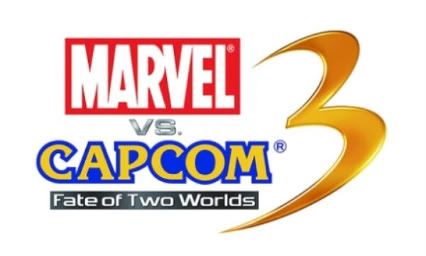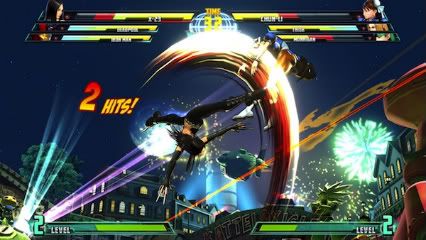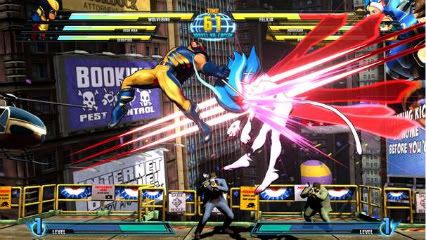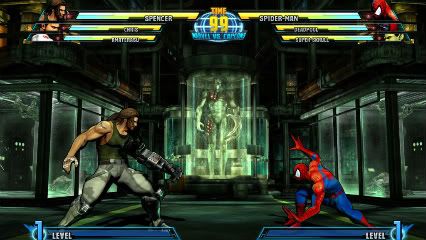
- Format: PS3 (version reviewed), Xbox360
- Unleashed: February 18th
- Publisher: Capcom
- Developer: Capcom
- Players: 1-2 (local), 2-8 (online)
- Site: http://marvelvscapcom3.com/
Fighting games that mix characters from different universes are extremely popular right now, with Smash Brothers still going strong and the likes of Dissidia 012 on the horizon. Following the success of Tatsunoko vs Capcom and the PSN/Live re-release of Marvel VS. Capcom 2, a new contender takes the stage.
In keeping with games in this sub-genre, the plot for MvC3 is as thin as it gets. With the help of Albert Wesker, Doctor Doom has assembled villains from both universes to conquer the world, an act which has inadvertently awoken a far more powerful enemy. This loose plot purely stands so that players can pit teams of three iconic characters from either universe against each other regardless of whether they are good, evil or somewhere in the middle like Hulk.

The first thing that will be obvious to those who have enjoyed previous games in the series will be the change in style. MvC3 features colourful 3D graphics (though is still fought on a 2D plane) and is extremely similar to the look of TvC. This may disappoint those hoping for the flat 2D sprites of old; but this style feels far more alive and animated, and adds a feeling of power to the already ridiculously spectacular attacks. The only downside to having so much going on in a visually flashy style (other than backgrounds so lively that they can be a distraction at times) is that MvC3 may be the first game where the ’15 minute break for every hour of playing’ health warning should be observed for fear of bringing out any latent epilepsy in you or – at the very least, mild eye strain.
Newcomers will care less about the visual style than returning fans, and they will instead be focused on how the core mechanics work. With a team of three from any of the 32 characters chosen (with four more being unlocked via very little in-game work), you chip away at your opponents while being able to call in support or swapping over characters at any point. As health is lost a red bar indicating chip damage remains, and this is slowly refilled when a character is not being used.

New to the series are air combos where, after launching an opponent into the air, you can use a connection attack that swaps out your active character to form a chain with your support. This also has a counter where the opponent being juggled can, with skill (or luck), press in the same direction as the other player wants to hit them and as a result knock them back. The second new addition is X-Factor, which swiftly heals all chip damage on the active character as well as providing a damage boost and acting as a method for extending combos. The duration X-Factor lasts is directly influenced by how many fighters in your team you have left, meaning its main use is as a last resort to turn a fight around.
If visiting MvC3 after playing the likes of SFIV, acclimatising to the different style of movement will be one of the first difficulties a player may have. Movement is just one of many things that differ between each character. Care has been taken to give a fresh experience to playing with all the heroes and villains, but regardless of who you pick you will still need to get used to the low gravity jumping speed and upward-launching super jumps.

Capcom stated fairly early on that they spent a lot of time on each character in order to achieve this feeling of uniqueness, and to a certain extent they have succeeded. Each character has abilities befitting them and each does feel slightly different; though until longer combo strings have been learned, leaning heavily on the new air combos mentioned above removes some individuality from characters. This may also feel like a bit of an excuse for why certain characters are not in the game. Though boasting 36 characters and two DLC characters on the way, this still pales in comparison to the 56 characters in MvC2.
Whether two characters play similarly or not would be less important to a fan than actually getting to play as them. Looking at how many people prefer Ken to Ryu or vice versa is a perfect example of this. It’s especially mysterious why fan favourites previously playable are gone, including the likes of Gambit, Mega Man, Venom and Strider. It is possible that even more characters will appear as DLC and that these will be far more desirable than the (already announced) premium costume packs.

After finding a team of three that you like, your choices of where to use them are fairly limited. Arcade Mode is a series of seven fights and Mission Mode (which might as well have just been called Trial Mode) is where you can learn increasingly complicated combos, but after that the only option is online play. Small additions like a time trial mode or survival mode would have helped.
Capcom has clearly put a lot of faith into how addictive the online battling component is. It’s a little annoying then that no spectator mode has been included for online lobbies, and those whose turn it isn’t must sit and watch two player licenses vibrate at each other instead of the actual battle – meaning a lobby of more than two people right now is pointless unless you are very patient.
Marvel vs Capcom 3 is an extravagant, over the top fighter that lacks the delicate balance of other games, but makes up for it with visual flare. Whether it will appeal to the tournament player or the casual player a few months down the line is up in the air, especially if all you see online is a team comprised of Dante, Arthur and Sentinel.








Comments